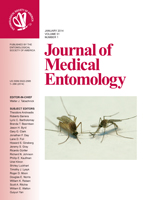Emerging infectious diseases are on the rise with future outbreaks predicted to occur in frontier regions of tropical countries. Disease surveillance in these hotspots is challenging because sampling techniques often rely on vector attractants that are either unavailable in remote localities or difficult to transport.Weexamined whether a novel method for producing CO2 from yeast and sugar produces similar mosquito species captures compared with a standard attractant such as dry ice. Across three different vegetation communities, we found traps baited with dry ice frequently captured more mosquitoes than yeast-baited traps; however, there was little effect on mosquito community composition. Based on our preliminary experiments,we find that this method of producing CO2 is a realistic alternative to dry ice and would be highly suitable for remote field work.
How to translate text using browser tools
1 January 2014
Overcoming the Challenges of Mosquito (Diptera: Culicidae) Sampling in Remote Localities: A Comparison of CO2 Attractants on Mosquito Communities in Three Tropical Forest Habitats
D. B. Meyer Steiger,
S. A. Ritchie,
S.G.W. Laurance
ACCESS THE FULL ARTICLE
It is not available for individual sale.
This article is only available to subscribers.
It is not available for individual sale.
It is not available for individual sale.

Journal of Medical Entomology
Vol. 51 • No. 1
January 2014
Vol. 51 • No. 1
January 2014
CO2 attractant
disease surveillance
emerging infectious disease
mosquito
yeast-generated CO2




